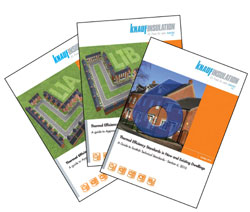Knauf Insulation Guides Specifiers through Part L and Section 6
With the revisions to Part L of the Building Regulations and Section 6 of Scotland’s Building Standards now firmly in place, Knauf Insulation has launched a series of guides to help specifiers make sense of the changes. Providing in depth yet practical advice, the guides cover Part L1A - new dwellings and Part L1B - existing dwellings and Section 6 of the Scottish legislation.

The changes in the legislation aim to reduce CO2 emissions across-the-board by an additional 25 per cent and 30 per cent in Scotland compared to current standards. The new regulations impose stringent thermal requirements and, for new buildings, compliance can only be shown after carrying out whole building energy performance calculations in accordance with the SAP 2009 methodology.
To aid specification, Knauf Insulation’s guides provide solutions for a wide variety of building elements, with detailed constructions and U-values calculated in accordance with relevant standards to allow specifiers to make sensible choices in order to meet the requirements. They also give details of a wide range of thermal insulation products, as Knauf Insulation is the only manufacturer to supply both glass and rock mineral wool and extruded polystyrene (XPS) products.
Importantly, the Part L guide outlines the challenges specifiers face in meeting requirements under both Part L and Part E (Resistance to the Passage of Sound), with regards to party walls. Research by Leeds Metropolitan University discovered heat entering a party wall is carried upwards by a flue type effect to be lost at roof level, meaning the U-value here is set at 0.50 W/m³K unless action is taken. Effective edge sealing brings the figure back to 0.20 W/m²K, while adding a fully filled solution, such as a loose blown-in glass mineral wool insulation, removes the penalty altogether.
Among the changes discussed in the guide to Part L1A and Section 6, is the tightening of elemental U-values in new residential buildings so that their area-weighted average is no more than 0.30 W/m²K for external walls, 0.20 W/m²K for roofs and 0.25 W/m²K for floors. In Scotland the figures are even more stringent, set at 0.25 W/m²K for external walls, 0.18 W/m²K for roofs and 0.20 W/m²K for floors. Openings (including windows, rooflights and external doors) must be 2.00 W/m²K, or 1.80 W/m²K in Scotland. Bearing in mind the lower CO2 emissions target, it is expected that developers will need to specify fabric elements lower than these limiting values in order to show compliance.
For refurbishment projects, the latest version of Part L1B seeks to reduce fossil fuel consumption and cut down the emissions of carbon dioxide from a building when an extension is built, a material change of use occurs, or the energy status of the building changes e.g. a loft or garage conversion. In this instance, fabric U-values have been tightened for external walls in particular with new build values moving from 0.35 W/m²K to 0.28 W/m²K and retained or replaced values moving from 0.35 W/m²K to 0.30 W/m²K.
Steve Smith, Knauf Insulation Market Manager, Residential New Build, said: “Knauf Insulation welcomes these substantial revisions to Part L and Section 6, and the impact they will have on the drive towards the Government’s zero carbon goal. As the only manufacturer to produce multiple types of insulation, we are pleased to be able to provide this guidance for specifiers.”
For more information and to download the guides visit http://www.knaufinsulation.co.uk or call 08700 668 660 to request a hard copy.
Ends
Article submitted by Knauf Insulation. More Knauf Insulation news here.
